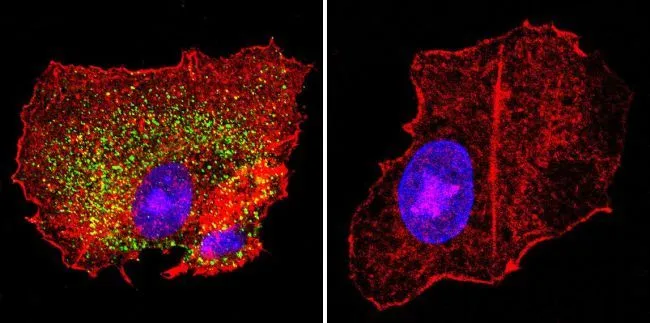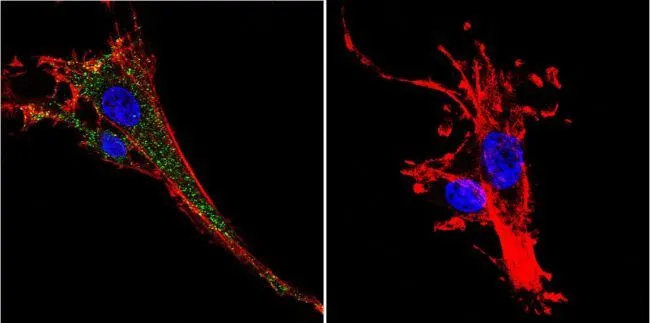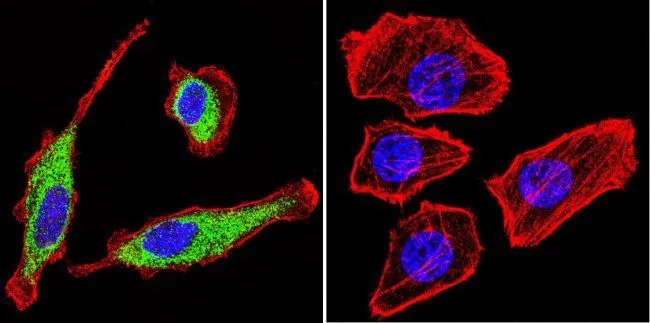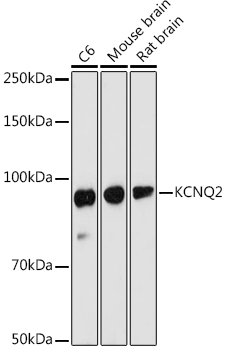
ICC/IF analysis of HepG2 cells using GTX82891 KCNQ2 antibody. Cells were probed without (right) or with(left) an antibody. Green : Primary antibody Blue : Nuclei Red : Actin Fixation : formaldehyde Dilution : 1:100 overnight at 4 oC
KCNQ2 antibody
GTX82891
ApplicationsImmunoFluorescence, Western Blot, ImmunoCytoChemistry, ImmunoHistoChemistry, ImmunoHistoChemistry Frozen, ImmunoHistoChemistry Paraffin
Product group Antibodies
ReactivityHuman, Mouse, Rat
TargetKCNQ2
Overview
- SupplierGeneTex
- Product NameKCNQ2 antibody
- Delivery Days Customer9
- Application Supplier NoteICC/IF: 0.5 microg/ml. IHC-Fr: 0.5 microg/ml. *Optimal dilutions/concentrations should be determined by the researcher.Not tested in other applications.
- ApplicationsImmunoFluorescence, Western Blot, ImmunoCytoChemistry, ImmunoHistoChemistry, ImmunoHistoChemistry Frozen, ImmunoHistoChemistry Paraffin
- CertificationResearch Use Only
- ClonalityPolyclonal
- Concentration1 mg/ml
- ConjugateUnconjugated
- Gene ID3785
- Target nameKCNQ2
- Target descriptionpotassium voltage-gated channel subfamily Q member 2
- Target synonymsBFNC, DEE7, EBN, EBN1, ENB1, HNSPC, KCNA11, KV7.2, potassium voltage-gated channel subfamily KQT member 2, neuroblastoma-specific potassium channel subunit alpha KvLQT2, potassium channel, voltage gated KQT-like subfamily Q, member 2, voltage-gated potassium channel subunit Kv7.2
- HostRabbit
- IsotypeIgG
- Protein IDO43526
- Protein NamePotassium voltage-gated channel subfamily KQT member 2
- Scientific DescriptionThe M channel is a slowly activating and deactivating potassium channel that plays a critical role in the regulation of neuronal excitability. The M channel is formed by the association of the protein encoded by this gene and a related protein encoded by the KCNQ3 gene, both integral membrane proteins. M channel currents are inhibited by M1 muscarinic acetylcholine receptors and activated by retigabine, a novel anti-convulsant drug. Defects in this gene are a cause of benign familial neonatal convulsions type 1 (BFNC), also known as epilepsy, benign neonatal type 1 (EBN1). At least five transcript variants encoding five different isoforms have been found for this gene. [provided by RefSeq, Jul 2008]
- ReactivityHuman, Mouse, Rat
- Storage Instruction-20°C or -80°C,2°C to 8°C
- UNSPSC12352203








